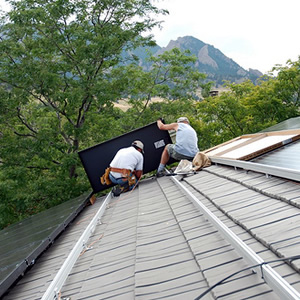- 328 reads

Think about it, having solar panels on your home would be really neat. Even without considering the ecological or monthly utility bill benefits, having solar panels on the roof of your home would make you pretty hip, and even moderately futuristic. Well, there’s a lot you need to know about solar panels before you make the step to install them on your home, and this article will help to guide you toward the most sensible photovoltaic option out there. We’ll start with some definitions.
Photovoltaic (PV) Module
This is another name for a solar panel, and it converts the suns energy into electricity. While PV modules come in all different types of shapes and sizes, the most common models found on homes are about 200 watts and 14 square feet.Photovoltaic (PV) Array
This is the term for a number of PV Modules strung together. The most common arrays consist of 2,000 and 5,000 watts, or more. With one module registering about 200 watts, this means the average array has 10-50 panels.Inverter
The panel will convert the suns energy into Direct Current (DC); however the system needs a way to change this into Alternating Current (AC) to be used around the house. This is where the inverter comes in, as it has the capability, with enough PV input, to supply the home with the AC it needs. Converters range in size from 2,000 to 7,000 watts, but can come in bigger sizes.Grid-Tied Solar System
This refers to a PV module or array and its inverter, whether mounted on the roof or the ground, which can connect and interact with the utility grid. Energy needed by the house is saturated, while the excess can be stored in the grid. Some energy companies will allow you to sell your extra energy to the grid at the current market value, and should you come to need that energy during a particularly sunless time, you will be free to purchase the energy back at the same market price.Kilowatt Hour (kWh)
This is the name for the 1 kilowatt (1,000 watts) of energy that is used in one hour. You are charged by the utility company by your use of kWhs. More easily explained, this is the product of power in kilowatt hours multiplied by time in hours. It is not kilowatts per hour, unless it is only one hour.Now, the three biggest factors that contribute to your readiness for solar panels are Daily Energy Requirements, Shade-free Space Available, and Project Budget.
Daily Energy Requirement
It is important to understand how much energy you use now, in order to best prepare for future consumption. Take a look at past utility bills to get a feel for your seasonal use, as some times you will need more energy than others. Look for the average kilowatt/day for the last year or so. You should also call your current energy provider, and ask about the “interconnection agreement,” which will be the contract between your PV array and the utility grid. After understanding your needs and the kilowatt/day figure, you will have a better idea of how big a system you will need.Shade-free Space Available
If even one of the panels in your array are covered, the overall effectiveness of the unit will drop dramatically. This is why it is important to pick a spot for your system that will have uninterrupted sunlight during the peak hours of the day (10am-3pm). Early and late day sun are not good providers of energy because they have much more atmosphere to go through before they reach your home. Shade-free space could be a limiting factor in your array’s size.Project Budget
Most PV arrays will set you back between $20,000 and $40,000. Theses figures may seem too steep, but the American Recovery and Reinvestment Act allows a 30% tax credit on qualifying solar panel installations with no cap. That could reduce the initial price tag by up to $12,000. On top of this, it is important to understand that you are making an investment in your future energy consumption. The panels may not be able to account for all the energy your home needs, but the system will begin to pay for itself immediately with about a 7-year payback time. After that point, it’s like having a free, and clean, energy machine attached to your home for the rest of the time you live there. It will also raise the resale value of your home dramatically.There is plenty of information out there on the web, so make sure you read up before taking the plunge. You can also talk to professionals to ensure you don’t make any troubling decisions too quickly.

